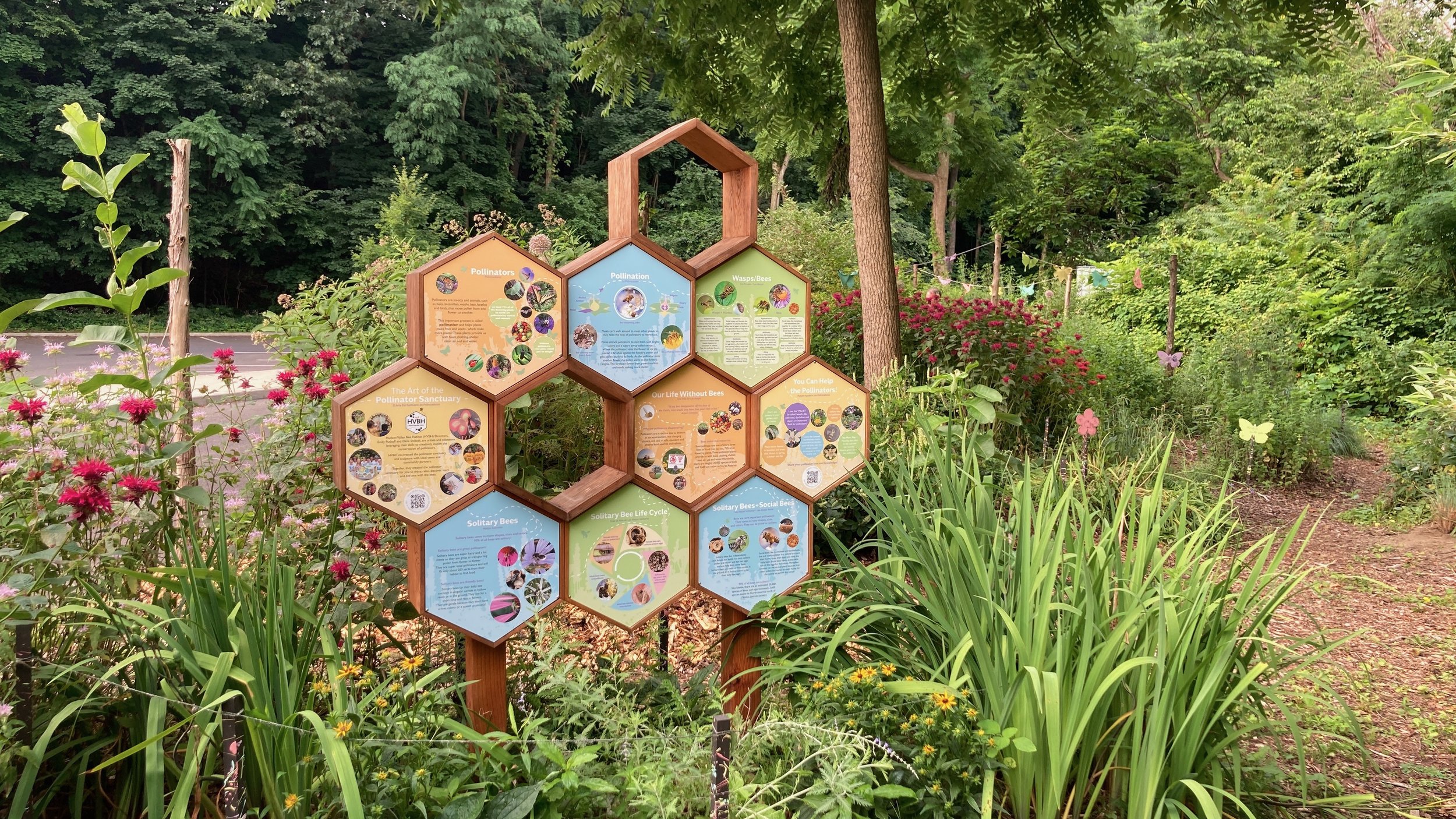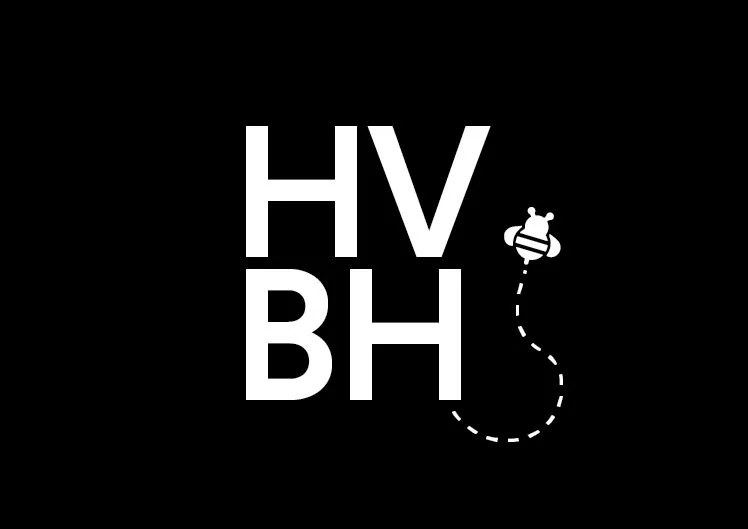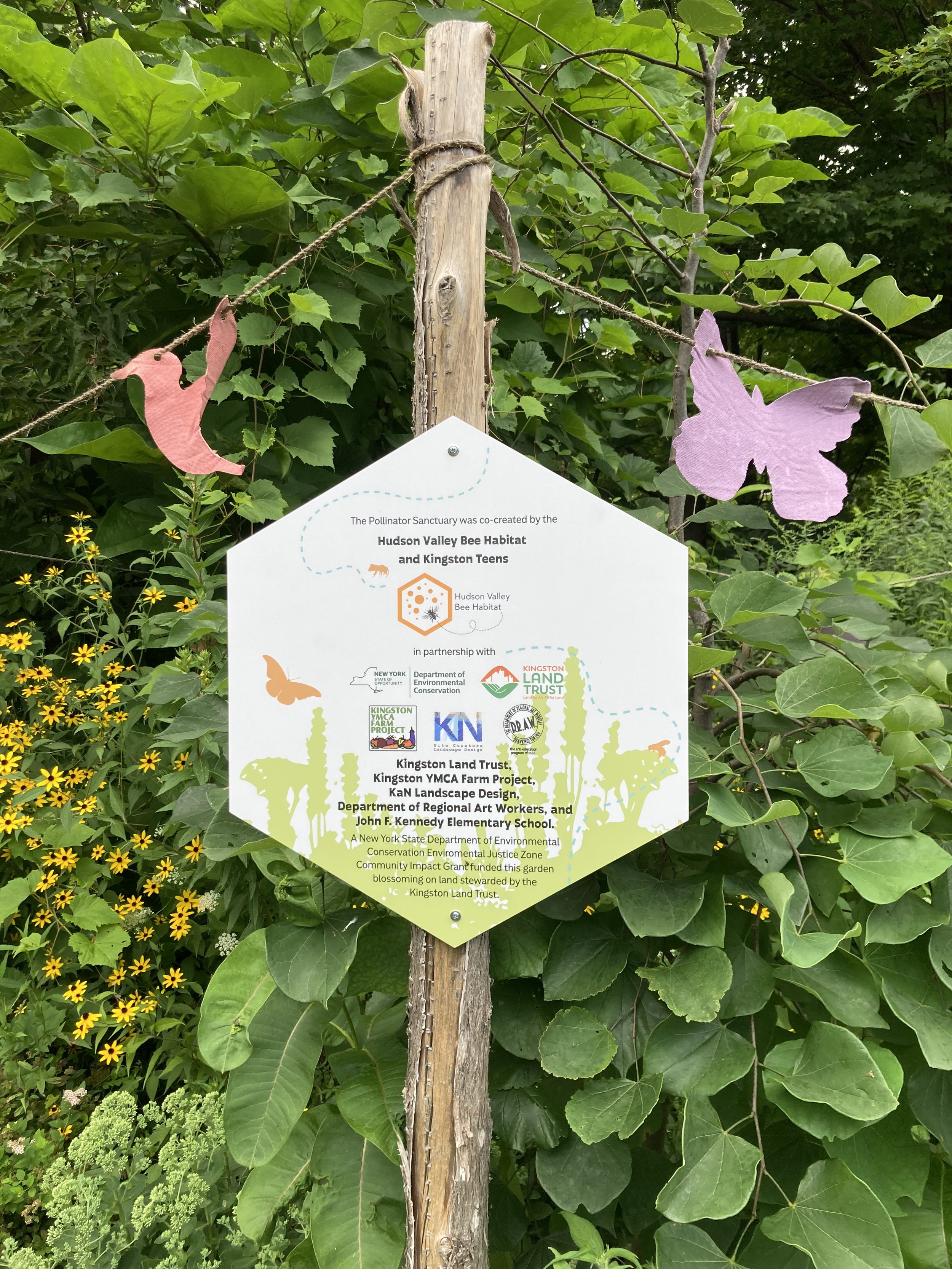
HVBH Projects

The Pollinator Sanctuary video documents HVBH’s co-creative process with Kingston teens and community partners, highlighting our arts-forward, embodied, collaborative, community-engaged design methodology.
Pollinator Sanctuary
The Pollinator Sanctuary is a haven for both pollinators and people! Located at 81 Gross St. in the Rondout neighborhood of Kingston, NY, it is across from JFK Elementary School on land stewarded by the Kingston Land Trust.
As a public artwork, it is open to everyone and accessible via the street or the Kingston Greenline Rail Trail.
When you visit the sanctuary, you are invited to Bee Calm, Bee Curious, and Bee Kind.
With the support of a Department of Environmental Conservation Environmental Justice Zone Community Impact Grant, we collaborated with local Kingston teens and community partners to transform an environmental justice zone site into a thriving and welcoming pollinator sanctuary.
We began the multi-year design process by collaborating with Kingston YMCA Farm Project teens. We mentored the teens in creating a biodiverse native landscape and pollinator habitat, using hands-on art activities to educate, empower, and inspire. Following our series of community-engaged design and pollinator education workshops, the teen design team established the core principles for the Pollinator Sanctuary: Curiosity, Fun, Diversity, and Education. Their intention was to create a haven for pollinators and a beautiful place for visitors to meander, explore, and discover.
KaN Landscape Design guided the design team in sensing the site and native, perennial plant design.
The garden design features leaf-like paths that offer a more organic experience than the asphalt parking lot next to the sanctuary. Each path branch includes zones for sensory observation, meditation, foraging, and learning. The design team incorporated the existing milkweed on-site into their design and created the "Bee One with the Bees" zone under the shade of a walnut tree.
A 'Scratch and Sniff' path offers an aromatic exploration featuring sage, fennel, marigold, apple mint, thyme, basil, lavender, lemon, and bee balm. The design team chose a weeping Eastern Redbud tree to welcome visitors with its heart-shaped leaves and to invite children to play under its branches.
Once the design was finalized, we set about building the soil and garden beds. As a former industrial site, the soil needed significant improvement. This process began several years earlier with the Kingston Land Trust. We layered cardboard sheets over the entire site, followed by several inches of mulch. This layer of organic matter naturally suppressed the weeds and decomposed to create soil. We also spread milkweed seeds, which grew into a core design element for the Pollinator Sanctuary.
Together with the teens, we laid out the pollinator sanctuary design and built the garden beds using a permaculture technique called hugelkultur, which involves layering wood, twigs, mulch, and soil to create a nutrient-rich and water-retaining soil bed. This technique proved effective when the garden survived a severe drought in its second year. After many barrels of mulch and soil, the beds were ready for planting

Using colorful dots to indicate plant types, the team created the native planting design by placing the dots on the site map. They followed several core principles:
Native Plants
Native plants have evolved alongside their pollinator partners, making them specifically tailored to a specific ecosystem. As a result, they are quite beneficial and resilient. Perennial plants require less maintenance, watering, and come back every year.
Plant in bunches
Pollinators prefer to visit many of the same flowers at once.
Seasonal variety
Pollinators like to eat every day just like us. Seasonal variety ensures plants bloom in different seasons so pollinators have food throughout spring, summer, and fall. For example, willow, eastern redbud, and tulips provide food in early spring, while asters, sedum, goldenrod, and joe-pye weed offer late fall forage.
Color diversity
Hummingbirds are attracted to red flowers, while bees, unable to see red, are drawn to white, yellow, and purple flowers.
Together with the community, we planted the first half of the garden.
We only planted half initially due to concerns about deer munching on the plants without any fencing.
To deter deer, we innovated several solutions:
Depth perception trick
Deer have poor depth perception as their eyes are on the sides of their heads. We strung twine along a lower line of signage stakes and hung colorful pollinator-shaped flags from higher cedar poles at a short distance from the stakes . The deer can't gauge the distance between the two roped-off areas, which makes them nervous and keeps them away.
Deer-resistant native varieties
Plants such as Juniper, Rudbeckia, Comfrey, Mountain Mint, Bee Balm, Echinacea, Aster, and Sedum.
Fragrant and fuzzy plants
We planted these on the edges of the paths as deer tend to avoid them.
Stinky solution
We frequently spritzed the plants with a stinky, organic mixture of garlic, eggs, and chili powder.
After the first year, we were elated to find that the deer avoided eating the plants, so we planted the second half of the garden.
In this section we introduced berry bushes, such as June and Blueberry, and the ‘Scratch and Sniff’ path for multi-sensory exploration.
Bee Habitat Sculpture
Centrally located in the sanctuary is a bee habitat sculpture composed of eleven cedar wood hexagons. These hexagons house solitary bee nesting materials, providing a safe and healthy way for solitary bees to nurture their young and offering humans an accessible means to observe these important pollinators. Decorative grills on the front of the sculpture, featuring organic and beautiful patterns, attract native bees and humans alike and protect the baby bees from predators.
The design of the grills was a collaborative effort with the teens of DRAW Kingston. We led them through a series of pollinator education and paper-cutting art workshops, where they created stencils of pollinators and plants. We then experimented with composition using a shadow puppet technique.
The rear of the sculpture features nine educational signs designed in collaboration with
Veronica Alvarez, our expert graphic designer.
Kingston Bee Line
The Bee Line is public art for people and pollinators! It features a growing network of pollinator gardens and bee habitat sculptures in Kingston, NY. The Beeline provides a pollinator pathway along the Greenline, an urban rail trail connecting the waterfront to uptown Kingston. Our first Bee Line node, the Pollinator Sanctuary, is located across from JFK Elementary in the Rondout neighborhood. We envision the Bee Line connecting across Kingston to other rail trails and pollinator pathways across New York and beyond.
Bee Habitat Gateway Arbor for the Akwesasne Seed Hub
Hudson Valley Bee Habitat was invited to create a bee habitat arbor that serves as the threshold into the Akwesasne Seed Hub at the Hudson Valley Farm Hub in Kingston, NY. “Seeds produced here are grown in support of seed and food sovereignty efforts in Akwesasne. Harvests return home to their people and provide seeds to plant the next season.”
HVBH consulted with Mary Arquette and other tribal leaders on the design for the arbor. They requested that the arbor take the form of the Hiawatha Belt, a symbol of the five nations of the Haudenosaunee living peacefully together. The arbor provides native solitary bees sanctuary in locally harvested hollow stems and wood cavities housed in the Hiawatha Belt form.
We see the diversity of life thriving together in the garden as beautifully congruous with the symbolism of the Hiawatha Belt. As one passes beneath the arbor into the garden, we hope they enjoy a moment of pause and reflection upon our interconnection with the soil, air, water, sunlight, species, and community that sustains us. We are deeply honored to contribute our hands, hearts, and art to help indigenous seeds survive and thrive.






























